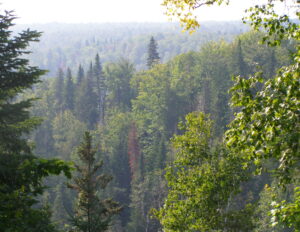Help protect New Brunswick’s forests!
New Brunswick’s Wabanaki/Acadian Forests dominate our landscape. Their long-lived, towering trees keep our rivers cool and filter their waters. They provide homes for iconic Canadian wildlife, including Canada lynx, American marten, flying squirrels, moose and barred owls.
They protect us from extreme flooding, erosion, drought and heat stress. Forest birds, bats and small mammals eat insects that harm trees or could otherwise become pests if left unchecked.
Forests are places for us to walk, hike, camp, and to simply get away to de-stress and connect with nature.
New Brunswick currently protects only 10% of our forests from development and industrial activity. That is way below the bare minimum needed to conserve our wildlife and wilderness values for the future. New Brunswick is lagging behind other provinces in Canada in the proportion of land we’ve protected.
Forests need more protection
We need more forests protected and managed to help protect communities and wildlife. Forests need to be conserved to do all these things:
- Protect the diversity and resilience of nature, so nature can continue to protect us;
- Maintain values important to the public and Indigenous communities, such as clean and abundant drinking water, places for outdoor connection, and thriving wildlife; and
- Sustain a wide variety of good jobs for communities.
Forests are under threat from industrial development, pollution, and habitat loss – and the pressures are growing. Climate change is bringing added threats:
- droughts,
- extreme flooding,
- heat waves,
- more frequent and intense forest fires,
- new insects and diseases – ones our forests haven’t had to deal with before.

Forest and wildlife experts are warning that New Brunswick’s forests have become degraded and weak over several decades of clearcutting, replacement of natural forests with plantations, and other industrial developments.
This has resulted in the steep loss of old forests and the tall canopies, deep soils and tree cavities that many forest birds and mammals need so they can thrive.
Studies are showing that even some common birds have declined by about half in New Brunswick since the 1980s, and other birds are at risk of disappearing from our forests.
Cold water areas in our rivers and streams are also suffering – causing extra concern for the ability of wild Atlantic salmon and brook trout to survive here.
The provincial government is under heavy pressure to expand industrial activities on Crown lands. But it’s clear that the current forest management system is not strong enough to protect wildlife, rivers and the nature that protects our communities.
